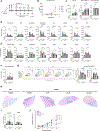IL-2 family cytokines IL-9 and IL-21 differentially regulate innate and adaptive type 2 immunity in asthma
- PMID: 39147327
- PMCID: PMC12255943
- DOI: 10.1016/j.jaci.2024.07.024
IL-2 family cytokines IL-9 and IL-21 differentially regulate innate and adaptive type 2 immunity in asthma
Abstract
Background: Asthma is often accompanied by type 2 immunity rich in IL-4, IL-5, and IL-13 cytokines produced by TH2 lymphocytes or type 2 innate lymphoid cells (ILC2s). IL-2 family cytokines play a key role in the differentiation, homeostasis, and effector function of innate and adaptive lymphocytes.
Objective: IL-9 and IL-21 boost activation and proliferation of TH2 and ILC2s, but the relative importance and potential synergism between these γ common chain cytokines are currently unknown.
Methods: Using newly generated antibodies, we inhibited IL-9 and IL-21 alone or in combination in various murine models of asthma. In a translational approach using segmental allergen challenge, we recently described elevated IL-9 levels in human subjects with allergic asthma compared with nonasthmatic controls. Here, we also measured IL-21 in both groups.
Results: IL-9 played a central role in controlling innate IL-33-induced lung inflammation by promoting proliferation and activation of ILC2s in an IL-21-independent manner. Conversely, chronic house dust mite-induced airway inflammation, mainly driven by adaptive immunity, was solely dependent on IL-21, which controlled TH2 activation, eosinophilia, total serum IgE, and formation of tertiary lymphoid structures. In a model of innate on adaptive immunity driven by papain allergen, a clear synergy was found between both pathways, as combined anti-IL-9 or anti-IL-21 blockade was superior in reducing key asthma features. In human bronchoalveolar lavage samples we measured elevated IL-21 protein within the allergic asthmatic group compared with the allergic control group. We also found increased IL21R transcripts and predicted IL-21 ligand activity in various disease-associated cell subsets.
Conclusions: IL-9 and IL-21 play important and nonredundant roles in allergic asthma by boosting ILC2s and TH2 cells, revealing a dual IL-9 and IL-21 targeting strategy as a new and testable approach.
Keywords: Asthma; IL-21; IL-9; adaptive immunity; innate immunity; monoclonal antibodies; type 2 immunity.
Copyright © 2024 The Authors. Published by Elsevier Inc. All rights reserved.
Conflict of interest statement
Disclosure statement This work was funded by a Baekeland Mandate of Flanders Innovation & Entrepreneurship (VLAIO) (HBC.2019.2598) to F.B. B.N.L. acknowledges support from a European Research Council (ERC) advanced grant (789384 ASTHMA CRYSTAL CLEAR), a concerted research initiative grant from Ghent University (GOA, 01G010C9), a Fonds Wetenschappelijk Onderzoek (FWO) Methusalem grant (01M01521) and an FWO Excellence of Science (EOS) Consortium research grant (3G0H1222), and the Flanders Institute of Biotechnology (VIB). H.H. is supported by a concerted research initiative grant from Ghent University (GOA, 01G010C9) and FWO EOS Consortium research grant (3G0H1222). M.J.S. acknowledges support from FWO Vlaanderen (12Y5322N), Fund Suzanne Duchesne (managed by the King Baudouin Foundation), and Fondation ACTERIA. Disclosure of potential conflict of interest: N. P. Smith is a consultant for Hera Biotech. A.-C. Villani has financial interest in 10X Genomics. B. D. Medoff serves on advisory boards for Sanofi, Verona Pharma, and Apogee Therapeutics and has sponsored research agreements from Sanofi and Regeneron. R. Bigirimana is an employee of argenx. C. Blanchetot is a consultant and shareholder of argenx. B. N. Lambrecht receives consultancy fees from GSK Biologics, Novartis, Sanofi, AstraZeneca, ALK, OncoArendi, and argenx and has research grants from ALK, argenx, AstraZeneca, GSK, GSK Biologics, and Johnson & Johnson. The rest of the authors declare that they have no relevant conflicts of interest.
Figures






References
-
- Hammad H, Lambrecht BN. The basic immunology of asthma. Cell 2021;184:1469–85. - PubMed
-
- Hekking PW, Wener RR, Amelink M, Zwinderman AH, Bouvy ML, Bel EH. The prevalence of severe refractory asthma. J Allergy Clin Immunol 2015;135:896–902. - PubMed
-
- Shah PA, Brightling C. Biologics for severe asthma—which, when and why? Respirology 2023;28:709–21. - PubMed

